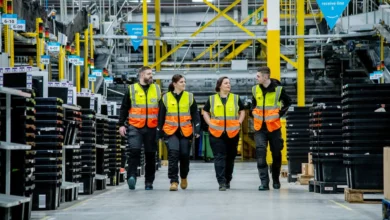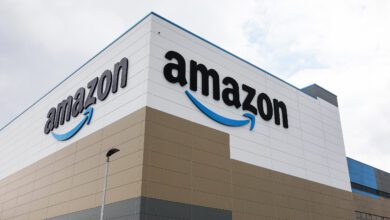Why retailers must change their data approach to overcome Amazon
Mike Fantis, VP and managing partner at DAC Group

The post-pandemic business landscape has seen retailers fast-track their digital efforts in an attempt to become truly omni-channel – and safeguard against a repeat of 2020’s disruption. Conversely (and perhaps more interestingly), we’re also getting a better sense of where bricks and mortar fits into the strategies of the digital-first players.
Amazon may recently have announced plans to close 68 high street shops, including all of its bookstores, but don’t be fooled into thinking it is retreating back to eCommerce. This is a tactical withdrawal from certain segments – physical stores still feature prominently in Amazon’s long-term plans.
Act now to beat Amazon
While Amazon won’t be troubling Waterstones on UK high streets, the company has confirmed it’s pursuing its ambitions to disrupt other offline categories including grocery, convenience and fashion. Physical touchpoints remain a key priority because they bring the digital giant one step closer to perfecting the formula for joining up on-and-offline customer journeys.
Amazon has what it takes to win on the high street too, at least in the long run; it is placed to evolve fast because it makes agility, flexibility and data its core competences. It’s the pragmatic focus on data that has most likely put an end to Amazon’s bookstores though. If something isn’t working, for whatever reason – think the ill-fated Fire phone – the company will cut its losses. Then almost immediately, it will regroup, adapt and go again.
Given time, Amazon will master its online-to-offline journey. The irony is, it’s actually the physical measurement that is the harder (and lengthier) piece to master. This is one significant advantage the incumbents have over the digital-first competition, this is especially the case if they already have store card and email receipt strategies in place. If high street brands act now, they still have a chance to beat Amazon to the punch in mastering the fully integrated customer journey. Here’s how:
Cut out siloed thinking
Where Amazon stands apart is how it is structured around data – its superpower is a 360-degree view of the customer. That sector-leading recommendation engine simply couldn’t exist in a siloed business that doesn’t share data.
While this level of personalisation may be a (much) longer term goal, how data is shared internally is a moot point and restructuring businesses around data can be both a practical and political challenge. As such, the first big step for many traditional retailers is simply to change the way they think about measuring and rewarding success. A woolly shared ethos won’t cut it. Instead, departmental and (to some extent) store KPIs need to be reconfigured to reflect success at a company-wide scale – and making this work is contingent on internal transparency and releasing internally siloed data.
Each team should understand the specific impact that it has on the wider customer journey. Even if their input can’t be attributed directly to the customer hitting ‘buy now’, they should be acutely aware of how their contribution to the customer’s decision-making process leads to a purchase. Key to this is taking a more holistic approach to reporting, which makes it easier to zoom out and focus on the bigger picture.
For example, if an organisation implements a consolidated media plan that everyone has access to, teams can identify overlapping objectives and support each other in meeting shared goals.
The PR department, for instance, could share useful content with the digital team in order to help them improve SEO and increase inbound traffic, adding value at the awareness and consideration levels of the purchase funnel. In turn, the digital team could reciprocate by helping PR with securing online coverage and backlinks that will raise the profile of announcements – further boosting awareness.
Virtuous circles drive growth, whilst inter-departmental rivalries hold it back.
Pay closer attention to intention
Active listening is key. Feedback collected from reviews and online sentiment can tell businesses what remedial action they need to focus on – improving the returns process or the customer experience, for example. But looking further up the sales funnel can be even more valuable.
Building a detailed customer profile by collecting and analysing data across both digital and physical touchpoints can pay huge dividends. The less siloed the approach, the more data there is to work with of course.
The more context you have around the user’s motivations for purchase, the better you will be able to engage the customer, both in the sales funnel itself and in after sales.
For example, a site search for running shoes could indicate that person is most likely interested in exercise. If this hypothesis tallies with additional data held in this customer’s profile; their age, gender, location, historical purchases etc, then it becomes clearer what sort of additional information could be genuinely useful to them.
Post-sale engagement could be emails offering details of local running clubs and routes, workout and nutrition plans – perhaps even to press the advantage of a physical presence by offering invitations to workshops at their local store. This value-add boosts the likelihood of customer retention – and as we know it’s much more cost effective to hold on to audiences than to acquire them. A fair value exchange incentivises the customer to remain opted in to comms, and is thus more likely to purchase from you again.
Enable brand-to-local campaigns
Given most traditional retail businesses still work in siloes, brand and performance campaigns have typically been run by different teams and usually in isolation. However, the lack of joined up thinking is most apparent in-store, where a carefully curated set of brand messages can quickly be reduced to empty sloganeering.
Having both on-and-offline properties should, in theory, double the potential for making a sale, particularly if the retailer employs a brand-to-local strategy to drive footfall to particular locations. However, the success of this approach is predicated on consistency of customer experience. As such, success in brand-to-local campaigns means ensuring company-wide values and messages are understood and upheld across all channels, whether that’s online or off – and that means across every store.
This does of course become harder the more an organisation grows – and especially for international companies working across multiple regions. Getting it right is a fast-track to turning customers into brand advocates though, something Apple has been able to cultivate through its global network of in-store ‘geniuses’.
By comparison, while Amazon’s decision to minimise human contact as far as possible in its own outlets does reduce risk to some extent, it isn’t going to deliver the heights of brand love reserved for Apple.
Joining-up the customer journey across on and offline channels has been a holy grail for retailers. Those that have made the transition are few and far between, but making it work could be the differentiator high street brands need in the face of digital-first competition.
People shop online because it’s convenient, at least to a point and depending on the category. There were clear spikes in footfall after each lockdown, and especially for segments like fashion where people were able to try on clothes again without having to go through the hassle of ordering two sizes and returning the one that didn’t fit.
Offering customers a brand experience that combines the best of both worlds is the key to holding on to the high street. Many of the incumbents already hold the offline data to challenge Amazon’s ambitions and potentially to do so at scale much faster. It’s an opportunity that’s there for the taking, but the longer they hold off, the smaller the window for success becomes.









